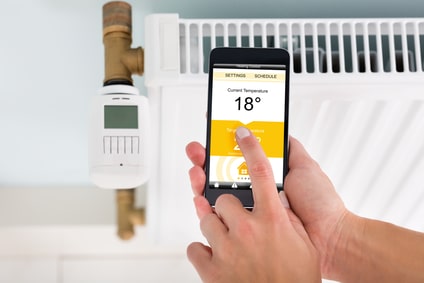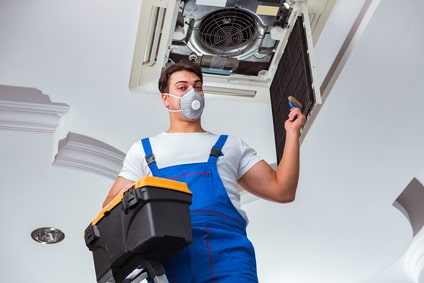The design of HVAC systems for both commercial and residential applications has undergone constant development over the years as new trends and principles have emerged. Today, a desire for “green,” energy efficient, and flexible modern building plans has created an exciting opportunity for engineers to integrate various methodologies to create truly innovative offerings for clients.
The creation of an HVAC design requires balancing a number of factors and finding the right parameters that are suitable for that particular space and its design requirements. Here is a look at five different ways that engineers can improve efficiency in their HVAC system designs. Included is a blend of mechanical and electronic technologies, along with their potential impacts on the building and environment.

Smart technologies are changing the way that homeowners manage their utilities and having an incredible impact on the efficiency of HVAC systems. One of the most dramatic and well-known products to enter the market has been smart thermostats, such as the Nest, which automatically control temperature and can be used to optimize energy savings based on the user’s preferences. As engineers, these are a great option for customers as they can be integrated into HVAC systems, operated from smart devices, and provide notifications about system faults or issues. Beyond thermostats, there are also tools available to engineers such as direct digital control (DDC) systems that can digitally monitor additional details about an HVAC system and in some cases even be used to diagnose problems remotely.
Computational fluid dynamics (CFD) are used to define a flow or thermal system through a series of differential equations. These equations allow visual modeling to be done for the movement of air in an enclosed space. By utilizing CFD modeling during the design of an HVAC system, the engineer can simulate various conditions and analyze their impact on the building or external environment. Some of the most frequently studied impacts include environmental exhaust, smoke and fire risks, and air quality. There are still many instances where manual and rough assumptions are made for a designed space that can lead to over-engineering and the purchase of oversized equipment. With today’s advancements in computing power, it has never been easier to utilize these more precise techniques to find an efficient balance of equipment, power, and space for your design.
Energy recovery ventilation (ERV) is an emerging process by which exhausted air is redirected to pretreat the incoming ventilation air of an HVAC system. This can have very noticeable impacts on the efficiency of the system as it can help to maintain a constant relative humidity of 40-50% within the indoor environment year-round. In addition, it allows the incoming air to be partially cooled in the summer months and heated in the winter months, helping to reduce the scale of equipment needed to maintain the desired temperature. Such ERV systems are part of the passive house design movement as they reduce the capital expense and energy requirements of the HVAC system and could be an attractive option to consider in your designs.
The passive survivability of a building represents how suitable the internal environment would remain as a shelter in the event of being cut off from utilities after a natural disaster or other catastrophic event. It is a design concept that emerged after Hurricane Katrina in 2005 as a comprehensive way to design elements into a building such as storm-resistance, natural ventilation, solar and other renewable energy systems, and rainwater storage. Many of these technologies are already part of green building design, but the key difference is looking at the system as a whole to assess its suitability as a prolonged shelter. Passive survivability has gained a great deal of support with some calling for it to become a future standard for construction of common building types.

While smart technologies such as IoT devices can transmit data to a centralized database for system monitoring, barcodes are essential for managing preventive maintenance. Staying on top of preventive maintenance keeps repair costs down and reduces downtime from unexpected breakdowns, while ensuring that HVAC equipment is operating at optimal efficiency. Keeping HVAC equipment in good working order through regular maintenance extends the asset’s usable lifespan, reducing the need for costly replacements.
By simply scanning a barcode label on a component, technicians can quickly and accurately document maintenance activities performed, creating a complete maintenance history of every asset and its various components. Equipment tagging paired with a CMMS or other preventive maintenance software solution also allows for easy parts reordering, linking all essential information about every asset from vendors to parts and model numbers, in a centralized database.
Choosing durable barcode solutions for equipment tagging is key. The material of choice for durable equipment identification in harsh operating environments like HVAC and energy applications for more than five decades, MPC’s Metalphoto® photosensitive anodized aluminum offers resistance to resistance to corrosion, sunlight degradation, abrasion, extreme temperatures, and chemical exposure to ensure readability throughout the lifespan of your HVAC assets.
As you can see, some of these ideas are new, but many are based on long-standing concepts that have been improved over the years. The use of modern electronic monitoring and computer simulations has made it possible to optimize systems like never before. As engineers take the opportunity to utilize and test new methods, they can have an impact on future HVAC design principles and set a higher bar. Modern HVAC design can be complex and presents a unique challenge to find solutions that will operate efficiently, safely, and economically for many years to come.
Our sales engineers are experts in automatic asset tracking, tagging and identification,a nd can answer all your questions. Get in touch now.
Lets Talk ›